Explore the comprehensive Colocasia Esculenta ‘Black Coral’ Care and Growing Guide. Learn effective tips for successful cultivation.
Check this Colocasia Esculenta ‘Black Coral’ Care and Growing Guide to uncover the secrets to nurturing this captivating plant, from essential care instructions to expert tips on fostering its vibrant growth.
Explore this Black Pothos: Scindapsus treubii ‘Dark Form’ Growing Guide
What is Colocasia Esculenta ‘Black Coral’?
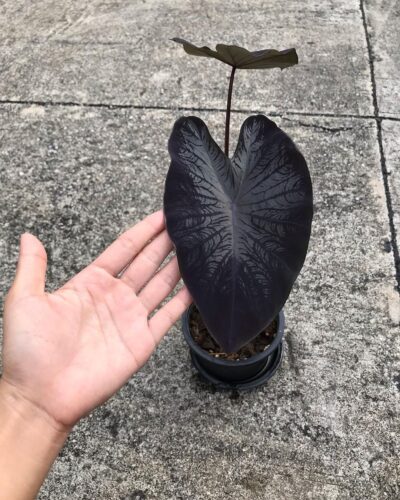
Colocasia esculenta ‘Black Coral,’ also known as Taro, is a plant with black, glossy, heart-shaped leaves. Unlike some other plants like Alocasia, its leaves hang downward towards the ground. The flowers it produces are somewhat like calla lilies, with greenish-yellow coverings. However, these flowers are not very showy and don’t appear often. ‘Black Coral’ is a low-maintenance tropical plant that can draw attention and create a nice background for other vibrant plants, especially when grown in containers.
It can reach a height of about 4 feet (120 cm) and a width of 3 feet (90 cm). Originally from tropical eastern Asia, people brought Colocasia esculenta to the Americas initially as a food crop for slaves. Later on, it was suggested as an alternative to potatoes. This plant can survive in a variety of wet and dry environments, and it can spread to places near water, like the edges of wetlands, swamps, and streams with dark water.
Note: Consuming any part of this plant without cooking can lead to mild stomach discomfort. It harms dogs, cats, and horses if they eat it.
Check out Tillandsia Magnusiana Care and Display Ideas
How to Propagate Colocasia Esculenta ‘Black Coral’
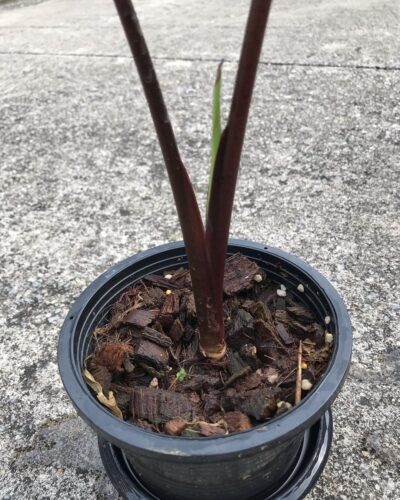
Division: This involves separating the plant into smaller sections, each with roots and shoots. It’s one of the easiest ways to propagate Colocasia Esculenta ‘Black Coral.’
Easiest Method – Division
- Choose a mature and healthy Colocasia Esculenta ‘Black Coral’ plant that you want to propagate.
- Gently dig up the plant from the soil, taking care not to damage the roots or the main plant.
- Shake off excess soil to expose the tuberous root structure and the connected shoots (baby plants).
- Use a clean, sharp knife or garden shears to carefully separate the shoots from the main tuber, ensuring each shoot has some roots attached.
- Plant each separated shoot in a new location or container, making sure the roots are covered with soil, and the shoot is at the appropriate depth.
- Water the newly planted shoots thoroughly to help them establish in their new location.
- Provide appropriate care by keeping the soil consistently moist and placing the new plants in a suitable environment with the right amount of light.
Division is preferred in spring or early summer when the plant is actively growing. This method is successful because each separate shoot already has its roots, making it easier for them to establish as individual plants. It’s essential to keep the newly divided plants well-watered and protected from harsh conditions until they are fully established.
Check out Dragon Tail Philodendron Care Guide
Propagating Colocasia Esculenta ‘Black Coral’ in Water
- Take a 6-8-inch cutting from a mature with a few leaves, healthy Colocasia Esculenta ‘Black Coral.’
- Place the cuttings in a jar or pot filled with non-chlorinated water.
- Change the water in a couple of days.
- Keep the container where it gets bright, indirect sunlight.
- When you notice roots are growing, transplant the cutting to the pot with soil.
Pot Size for Growing Colocasia Esculenta ‘Black Coral’
For Colocasia Esculenta ‘Black Coral,’ start with a 10-12 inch diameter pot for initial planting. Use a mix of potting soil and compost for good drainage. When repotting, choose a slightly larger pot every 1-2 years. Opt for well-draining soil, and add perlite for improved aeration. Ensure pots have drainage holes to prevent waterlogging.
Explore Black Majesty Philodendron Care Guide
Ideal Growing Conditions for Colocasia Esculenta ‘Black Coral’
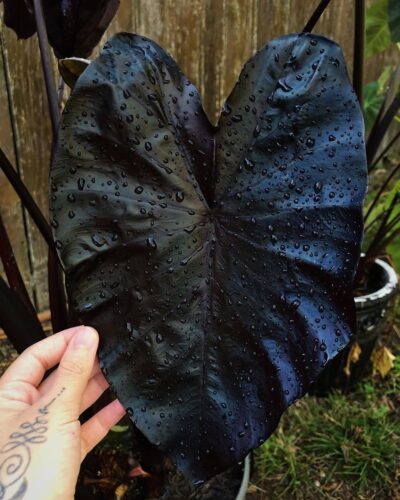
Sunlight
Colocasia Esculenta ‘Black Coral’ thrives in bright, indirect light. Place it where it gets filtered sunlight or morning sun with afternoon shade. Avoid direct, harsh sunlight that can scorch its leaves. Keep it facing east or north for optimal sun exposure. Regularly rotate the plant for even growth and prevent leaning.
Soil
It prefers well-draining soil. A mix of equal parts potting soil, compost, and perlite or sand works well. Aim for a slightly acidic to neutral pH level of 6.0 to 7.0. Good drainage is crucial to prevent waterlogged roots. Adding organic matter enhances soil structure and nutrient retention for healthy growth.
Watering
Water Colocasia Esculenta ‘Black Coral’ regularly to keep the soil consistently moist but not soggy. Water deeply, allowing excess water to drain. In warmer months, water the plant more frequently and reduce in winter. Use room-temperature water to avoid shocking the plant. Mulching helps retain moisture. Wilting indicates underwatering while yellowing may signal overwatering.
Temperature and Humidity
Colocasia Esculenta ‘Black Coral’ thrives in temperatures between 65°F to 85°F. It prefers a humid environment with around 60-80% humidity.
It is well-suited for USDA Zones 8-11.
Learn How to Grow Blue Stargazer Lily
Colocasia Esculenta ‘Black Coral Care
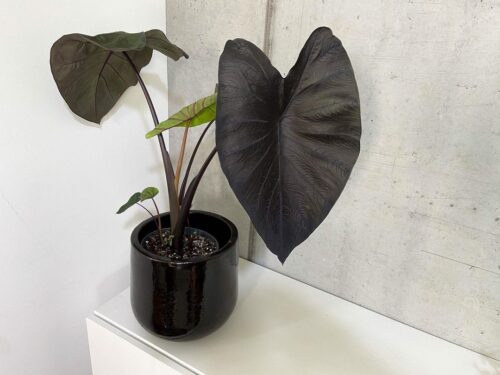
Fertilizer
Colocasia Esculenta ‘Black Coral’ benefits from a balanced fertilizer with a ratio of 10-10-10 or 14-14-14. During the growing season, apply the fertilizer every 4-6 weeks to provide essential nutrients for healthy growth. Avoid fertilizing during dormancy, which typically occurs in the winter months. Important fertilizers include general-purpose granular fertilizers and well-composted organic matter. Always follow the package instructions and adjust based on your plant’s needs.
Pruning
Pruning Colocasia Esculenta ‘Black Coral’ helps maintain its health and appearance. Remove dead or yellowing leaves at the base to encourage new growth. You can do pruning throughout the year, focusing on removing damaged or spent leaves. Use clean, sharp tools to prevent disease spread.
Pests and Diseases
Pests:
- Aphids are tiny insects that feed on plant sap, causing distorted growth. Spray plants with a strong stream of water or use insecticidal soap.
- Spider Mites are minuscule pests that suck the plant’s juices, leading to stippled leaves and webbing. Increase humidity and use neem oil or insecticidal soap.
- Mealybugs are pests that create white, cottony clusters in leaf axils and on stems. Remove them manually, or use insecticidal soap.
- Slugs and Snails: These creatures can make holes in leaves. Use beer traps, diatomaceous earth, or handpicking to control them.
Diseases:
- Leaf Spot: Fungal diseases like leaf spot cause brown or black spots on leaves. Remove affected leaves and improve air circulation.
- Root Rot: Overwatering can lead to root rot, causing the plant to wilt. Ensure well-draining soil and avoid waterlogged conditions.
- Bacterial Blight: This causes water-soaked lesions on leaves and stems. Remove affected parts and disinfect tools to prevent spreading.
- Powdery Mildew: A white powdery substance on leaves indicates powdery mildew. Improve air circulation and use fungicidal sprays.
READ Dracaena Hawaiian Sunshine Care Information
FAQs
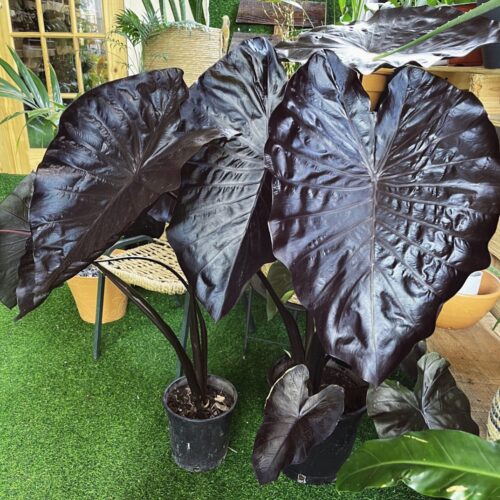
Q: Can I grow Colocasia Esculenta ‘Black Coral’ indoors?
A: Yes, you can grow it indoors if you provide it with bright, indirect light and maintain the required humidity levels. Be cautious of its size, as it can grow quite large.
Q: What’s the best planting time for Colocasia Esculenta ‘Black Coral’?
A: Plant in the spring after the last frost when the temperatures are consistently above 50°F (10°C). This helps the plant establish well before colder weather.
Q: Can I keep Colocasia Esculenta ‘Black Coral’ in a pond or water garden?
A: Yes, it can thrive in waterlogged conditions or partially submerged in shallow water, making it an excellent choice for water gardens or near ponds.
Q: What’s the significance of the ‘Black Coral’ variety’s dark leaves?
A: The dark leaves add an intriguing contrast to other plants in your garden, creating a bold and exotic visual appeal that’s highly sought after by many gardeners.
Q: What’s the best way to overwinter Colocasia Esculenta ‘Black Coral’ in colder climates?
A: Before the first frost, carefully dig up the rhizomes, remove excess soil, and let them dry for a day. Store them in a cool, dry place (around 50-60°F) in peat moss or sawdust until spring.



